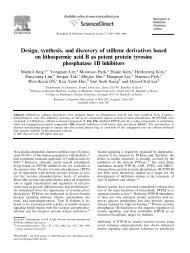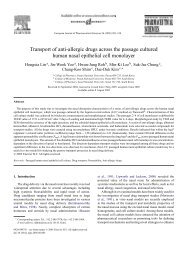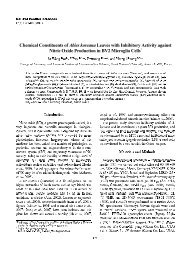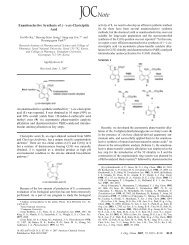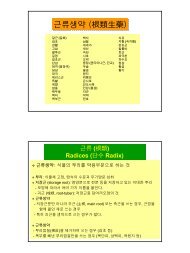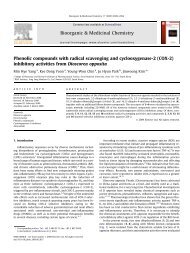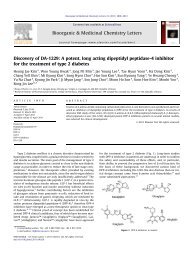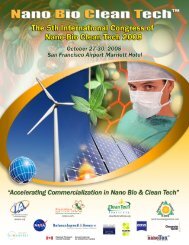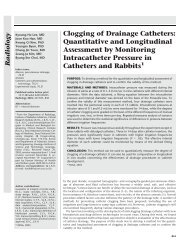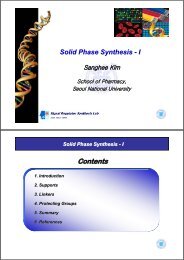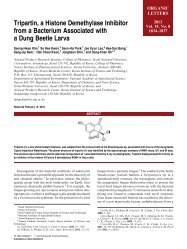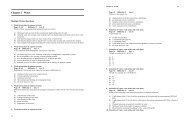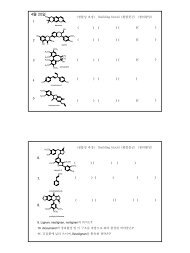Supercritical Fluid Extraction and Liquid Chromatography ...
Supercritical Fluid Extraction and Liquid Chromatography ...
Supercritical Fluid Extraction and Liquid Chromatography ...
Create successful ePaper yourself
Turn your PDF publications into a flip-book with our unique Google optimized e-Paper software.
1294 Notes Chem. Pharm. Bull. 50(9) 1294—1296 (2002) Vol. 50, No. 9<br />
<strong>Supercritical</strong> <strong>Fluid</strong> <strong>Extraction</strong> <strong>and</strong> <strong>Liquid</strong> <strong>Chromatography</strong>-Electrospray<br />
Mass Analysis of Vinblastine from Catharanthus roseus<br />
Young Hae CHOI, a,c Ki-Pung YOO, b <strong>and</strong> Jinwoong KIM* ,c<br />
a GreenTek21 Co., Ltd.; #10–132, Yeomri-dong, Mapo-gu, Seoul 121–870, Korea: b Department of Chemical Engineering,<br />
Sogang University; Seoul 121–742, Korea: <strong>and</strong> c College of Pharmacy <strong>and</strong> Research Institute of Pharmaceutical Sciences,<br />
Seoul National University; Seoul 151–742, Korea. Received May 7, 2002; accepted June 3, 2002<br />
<strong>Supercritical</strong> fluid extraction using carbon dioxide modified with methanol, methanol–diethylamine, or<br />
methanol–triethylamine was used to extract vinblastine from the aerial portions of Catharanthus roseus. An<br />
HPLC-electrospray ionization (ESI)/MS analysis method was also developed to quantify the alkaloids in these<br />
extracts. Of the supercritical solvents evaluated, carbon dioxide–methanol–triethylamine (80 : 18 : 2) at 80 °C <strong>and</strong><br />
34.0 MPa greatly improved the supercritical fluid extraction (SFE) yield of vinblastine by as much as 76.4% over<br />
methanol extraction, while the other solvent conditions extracted the compound at yields less than 25% that of a<br />
methanol extraction. These results were confirmed by the robust HPLC-ESI/MS analytical method developed in<br />
this study.<br />
Key words<br />
Catharanthus roseus; vinblastine; HPLC-electrospray ionization (ESI)/MS; supercritical fluid extraction<br />
Catharanthus roseus (L.) G. DON contains a variety of indole<br />
alkaloids <strong>and</strong> is used as antitumor, hypotensive, <strong>and</strong> antiarrhythmic<br />
agents. Among these indole alkaloids, vinblastine<br />
(1) <strong>and</strong> vincristine (2) (Fig. 1) are currently used to treat<br />
a wide variety of neoplasms <strong>and</strong> is recommended for treatment<br />
of Hodgkin’s disease, acute leukemia, <strong>and</strong> choriocarcinoma<br />
which is resistant to other types of therapy. 1,2) The<br />
unique antitumor activities of these indole alkaloids have resulted<br />
in a great dem<strong>and</strong> for vinblastine (1) <strong>and</strong> vincristine<br />
(2) as anticancer agents. Therefore, several attempts haven<br />
been made to develop optimum extraction methods for these<br />
alkaloids in order to satisfy the dem<strong>and</strong>. However, it is very<br />
difficult to develop a method for the extraction <strong>and</strong> analysis<br />
of these compounds because of their low content, less than<br />
1 g/500 kg. Previously developed extraction methods involved<br />
aqueous or alcohol extraction followed by pH control<br />
<strong>and</strong> re-extraction with an organic solvent. 3—5) They involve a<br />
long <strong>and</strong> tedious procedure <strong>and</strong> the use of large quantities of<br />
toxic organic solvents. Conventional analytical methods<br />
using HPLC-UV require a pre-purification procedure in<br />
order to remove compounds which interfere with the detection<br />
of the target compounds. 6,7) Therefore, an alternative<br />
method for the extraction <strong>and</strong> analysis of vinblastine (1) <strong>and</strong><br />
vincristine (2) from C. roseus would be highly desirable.<br />
We recently developed an supercritical fluid extraction<br />
(SFE) method for the extraction of alkaloids such as<br />
cephalotaxine, ephedrine, hyoscyamine, <strong>and</strong> scopolamine<br />
from plant materials using a basic modifier, which increases<br />
the solubility <strong>and</strong> degree of desorption from the matrix. 8—10)<br />
Therefore, we applied basified supercritical CO 2 as an extraction<br />
solvent in SFE for vinblastine (1) <strong>and</strong> vincristine (2) <strong>and</strong><br />
developed a method to analyze these alkaloids using HPLCelectrospray<br />
ionization (ESI)/MS.<br />
Experimental<br />
Plant Material <strong>and</strong> Chemicals The aerial portions <strong>and</strong> roots of Catharanthus<br />
roseus (L.) G. DON were collected from the Medicinal Plant Garden,<br />
College of Pharmacy, Seoul National University in May, 2001. The plant<br />
materials were freeze dried for 48 h <strong>and</strong> then pulverized. HPLC grade acetonitrile,<br />
methanol, <strong>and</strong> water were purchased from Merck (Darmstadt, Germany).<br />
Ammonium acetate, vinblastine, <strong>and</strong> vincristine were purchased<br />
from Sigma (St. Louis, MO, U.S.A.).<br />
Organic Solvent <strong>Extraction</strong> The aerial portions <strong>and</strong> roots (200 mg)<br />
were extracted with methanol (50 ml3) <strong>and</strong> evaporated in vacuo. Each extract<br />
was dissolved in 1 ml methanol <strong>and</strong> filtered through a 0.45 mm PVDF<br />
membrane filter (Kenosha, WI, U.S.A.). These experiments were conducted<br />
in triplicate.<br />
<strong>Supercritical</strong> <strong>Fluid</strong> <strong>Extraction</strong> SFE was performed using an Isco supercritical<br />
fluid extractor, model SFX 3560 equipped with two Isco 260 D<br />
syringe pumps (Lincoln, NE, U.S.A.) using CO 2 (99.9%, Seoul Gas Co.<br />
Seoul, Korea) in the pressure range of 10.2—34.0 MPa at 40, 60, <strong>and</strong> 80 °C.<br />
In each experiment, 200 mg of aerial portions of C. roseus was loaded into<br />
an extraction cell (57 mm20 mm i.d., Isco). The temperature of the restrictor<br />
was maintained at 80 °C (2 °C) <strong>and</strong> the static extraction time was 50<br />
min. The flow rate was 1.0 ml/min through the extraction vessel during the<br />
dynamic extraction time. The total amount of CO 2 consumed was 50 ml during<br />
the dynamic extraction at each condition. For the evaluation of the effects<br />
of modifiers such as methanol, diethylamine in methanol, <strong>and</strong> triethylamine<br />
in methanol (10%, v/v), each modifier was continuously incorporated<br />
into the extraction cell at concentrations of 1, 5, 10, <strong>and</strong> 20% (v/v) through a<br />
syringe pump at 80 °C <strong>and</strong> 34.0 MPa. All extracted analytes were collected<br />
in 20 ml vials containing 10 ml of methanol. After evaporation, each extract<br />
was re-dissolved in 1 ml methanol <strong>and</strong> filtered through a 0.45 mm PVDF<br />
membrane filter (Kenosha, WI, U.S.A.). These experiments were conducted<br />
in triplicate.<br />
HPLC-ESI/MS Analysis An Agilent 1100 series HPLC system equipped<br />
with an autosampler, a photodiode array detector, a column oven, a binary<br />
pump <strong>and</strong> a degasser (Agilent, Waldbronn, Germany) was used. Separation<br />
of the vinblastine <strong>and</strong> vincristine were performed using a Zorbax<br />
Bonus RP-18 (150 mm2.1 mm, particle size 5 mm, Agilent) at 40 °C. The<br />
mobile phase system was a gradient of 20 mM ammonium acetate-acetonitrile<br />
(0 min, 70 : 30; 30 min, 25 : 75; 45 min, 25 : 75). The flow rate of the<br />
mobile phase was 0.2 ml/min <strong>and</strong> 5 ml of sample solution was injected via<br />
the autosampler. The analysis of the vinblastine <strong>and</strong> vincristine detection<br />
Fig. 1. Chemical Structures of Vinblastine (1) <strong>and</strong> Vincristine (2)<br />
∗ To whom correspondence should be addressed. e-mail: jwkim@snu.ac.kr © 2002 Pharmaceutical Society of Japan
September 2002 1295<br />
Fig. 2.<br />
Total Ion Current (TIC), <strong>and</strong> Extract Ion Current (EIC) Chromatograms of Vinblastine (1) <strong>and</strong> Vincristine A (2), <strong>and</strong> Their Mass Spectra<br />
(A) TIC of a mixture of vinblastine (1) <strong>and</strong> vincristine (2). (B) EIC of a mixture of vinblastine (1) at m/z 811 <strong>and</strong> vincristine (2) at m/z 825. C; Mass spectrum of vinblastine (1).<br />
(D) Mass spectrum of vincristine (2).<br />
Table 1. Yield (mg/gS.D.) a) of Vinblastine (1) <strong>and</strong> Vincristine (2) from<br />
the Aerial Portions <strong>and</strong> Roots of Catharanthus roseus by Methanol <strong>Extraction</strong>*<br />
Sample Vinblastine (1) Vincristine (2)<br />
Aerial parts 46.602.11 Trace amount a)<br />
Roots 6.301.43 Trace amount a)<br />
∗ All experiments based on triplicate.<br />
1 mg/g.<br />
a) Content of the compound was less than<br />
were performed using an Agilent 1100 LC/MSD ion trap mass spectrometer<br />
(Agilent, Waldbronn, Germany) equipped with an electron spray ionization<br />
interface. Nitrogen was used as a nebulizing gas at a pressure of 20 psi at<br />
5 l/min, temperature at 350 °C <strong>and</strong> capillary voltage 1.1 kV. HPLC-<br />
ESI/MS analyses were carried out in the positive ion mode with the scan<br />
range m/z 100—1500.<br />
Results <strong>and</strong> Discussion<br />
We found that a better sensitivity of vinblastine (1) <strong>and</strong><br />
vincristine (2) could be achieved in ESI/MS using the positive<br />
ion mode compared to a UV detector (254 or 298 nm).<br />
Using this method, it was possible to detect levels as low as<br />
1.0 ng of these alkaloids with st<strong>and</strong>ard samples.<br />
The ESI/MS spectra of vinblastine (1) <strong>and</strong> vincristine (2)<br />
in the positive ion mode both displayed [MH] at m/z 811<br />
<strong>and</strong> 825, respectively, as a base peak as shown in Fig. 2.<br />
Therefore, MS detection was operated in the positive ion<br />
mode in the scan range m/z 100 to 1500, <strong>and</strong> the analysis of<br />
these indole alkaloids was performed using the extract ion<br />
current (EIC) mode targeted at m/z 811 <strong>and</strong> 825. Concentrations<br />
of the st<strong>and</strong>ard solution used in this experiment were in<br />
the range 0.4—30 mg/ml, <strong>and</strong> the linear correlation coefficient<br />
(g 2 ) of vinblastine (1) <strong>and</strong> vincristine (2) were determined<br />
to be 0.9965 <strong>and</strong> 0.9951, respectively. Based on this<br />
calibration curve, the amount of these alkaloids in C. roseus<br />
were calculated (Table 1). The content of vinblastine (1) is 7<br />
times higher in the aerial portions than the roots, but the vincristine<br />
(2) was found in trace amounts (1 mg/g in both<br />
plant parts). As shown in Fig. 3, the EIC chromatogram of<br />
the extract allowed the separation of these alkaloids without<br />
the need for any purification step which is not obtainable by<br />
conventional analytical methods. Thus, the HPLC-ESI/MS<br />
Fig. 3. UV (254, 298 nm), TIC, <strong>and</strong> EIC Chromatograms of the Aerial<br />
Parts of C. roseus Obtained by Methanol <strong>Extraction</strong><br />
A, UV (254 nm) chromatogram of the extract; B, UV (298 nm) chromatogram of the<br />
extract; C, TIC of the extract; D, EIC of the extract at m/z 811, E; EIC of the extract at<br />
m/z 825.<br />
developed in this study is a simple <strong>and</strong> rapid analytical<br />
method with no need for a clean-up step <strong>and</strong> represents a<br />
promising analytical method for the detection of specific<br />
compounds from a complex plant matrix.<br />
Our previous reports showed that a small addition of a<br />
basic modifier could dramatically enhanced the SFE yields<br />
of some alkaloids such as cephalotaxine, ephedrine,<br />
hyoscyamine <strong>and</strong> scopolamine. 8—10) This can be attributed to<br />
the fact that salts of alkaloids in plant tissues might be converted<br />
to free bases by the basic modifiers. This change can<br />
enhance the solubility of a compound in carbon dioxide as<br />
well as the degree of desorption from the plant matrix. As<br />
expected, an increase in temperature <strong>and</strong> pressure had no influence<br />
on the SFE efficiency of vinblastine (1) because of its<br />
high polarity when pure carbon dioxide was used as a solvent.<br />
Moreover, the addition of methanol did not significantly<br />
improve the SFE yields. However, the addition of basified<br />
modifier such as diethylamine or triethylamine to the mixture<br />
of carbon dioxide <strong>and</strong> methanol resulted in a great increase<br />
in the yield of vinblastine (1). A mixture of carbon dioxide–
1296 Vol. 50, No. 9<br />
methanol–triethylamine (80 : 18 : 2) at 80 °C <strong>and</strong> 34.0 MPa<br />
was especially effective in extracting this compound by as<br />
much as 76.6% compared to methanol extraction, while the<br />
other supercritical solvents evaluated in this experiment extracted<br />
less than 25% of that obtained by methanol extraction.<br />
On the basis of these results, SFE using basic modifier<br />
such as triethylamine developed in this study appear to be an<br />
alternative extraction method for vinblastine (1) compared to<br />
conventional organic solvent extraction.<br />
Fig. 4. <strong>Extraction</strong> Yield of Vinblastine (1) from the Extract of the Aerial<br />
Portions of C. roseus Using Carbon Dioxide–Methanol (80 : 20) at 80 °C <strong>and</strong><br />
34.0 MPa (CM), Carbon Dioxide–Methanol–Diethylamine (80 : 18 : 2) at<br />
80 °C <strong>and</strong> 34.0 MPa (CMD), Carbon Dioxide–Methanol–Triethylamine<br />
(80 : 18 : 2) at 80 °C, 34.0 MPa (CMT), <strong>and</strong> Methanol (M)<br />
References<br />
1) Tyler V. E., Brady L. R., Robbers J. E., “Pharmacognosy,” Lea &<br />
Febiger, Philadelphia, 1981, pp. 237—239.<br />
2) Lu M. C., “Cancer Antimitotic Agents,” ed. by Foye W. O., American<br />
Chemical Society, Washington DC, 1995, pp. 345—368.<br />
3) Tillequin F., Michel S., Sequin E., “Methods in Plant Biochemistry,”<br />
Vol. 8, ed. by Waterman P. G., Academic Press, San Diego, 1995, pp.<br />
309—372.<br />
4) Monforte-Gonzalez M., Ayora-Talavera T., Maldonado-Mendoza I. E.,<br />
Loyola-Vargas V. M., Phytochem. Anal., 3, 117—121 (1992).<br />
5) Renaudin J. P., Physiol. Veg., 23, 281—388 (1985).<br />
6) Verzele M., De Taeye L., Van Dyck J., De Decker G., J. Chromatogr.,<br />
214, 93—99 (1981).<br />
7) Miura Y., Hirata K., Kurano N., Miyamoto K., Uchida K., Planta<br />
Med., 54, 18—20 (1988).<br />
8) Choi Y. H., Kim J., Kim J. Y., Joung S. N., Yoo K. P., Chang Y. S.,<br />
Arch. Pharm. Res., 23, 163—166 (2000).<br />
9) Choi Y. H., Kim Y., Kim J., Yoo K. P., Chromatographia, 50, 673—<br />
679 (1999).<br />
10) Choi Y. H., Chin Y. W., Kin J., Jeon S. H., Yoo K. P., J. Chromatogr. A,<br />
863, 47—55 (1999).



